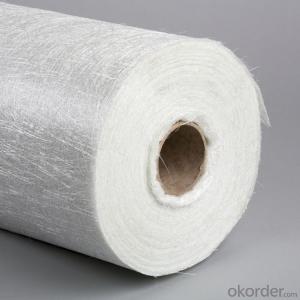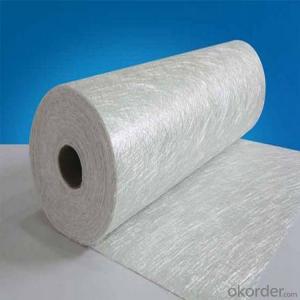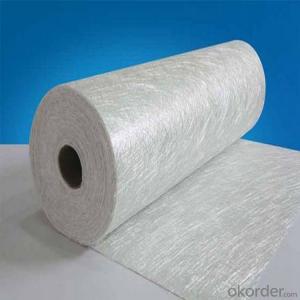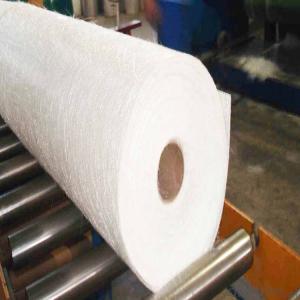100g/m2 Fiberglass Chopped Strand Mat
- Loading Port:
- China main port
- Payment Terms:
- TT OR LC
- Min Order Qty:
- 1 kg
- Supply Capability:
- 5000 kg/month
OKorder Service Pledge
OKorder Financial Service
You Might Also Like
Product Description:
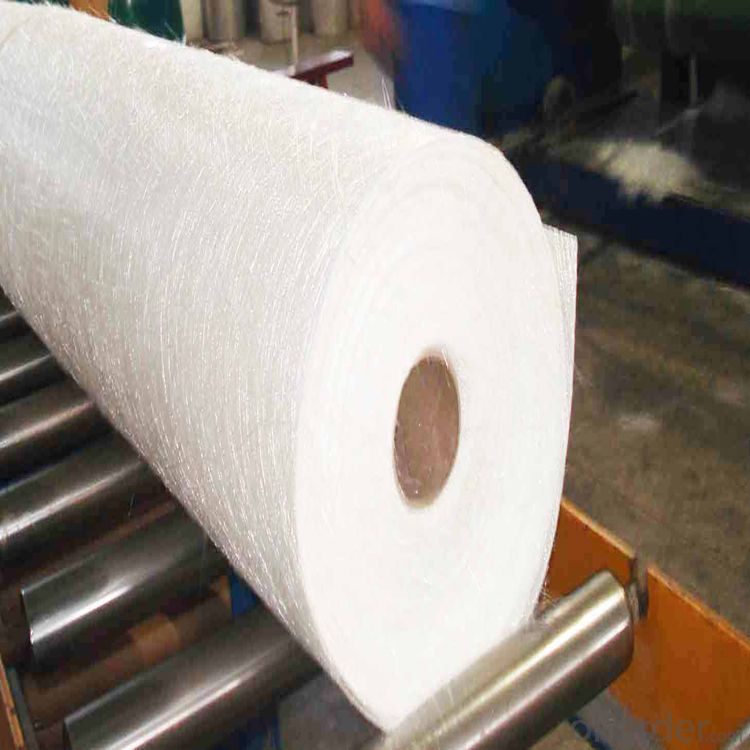
Surfacing Tissue mainly used in the surface layers of FRP products. It features even Fiber distribution, soft feel, level and smooth fiber surface, less glue content, quick resin soak and good pattern fitness. It can improve the product surface property on corrosion resistance, compressive strength, seepage resistance, and longer service life. It is also suitable for spraying; pattern pressing and other FRP pattern technology.
Surfacing Tissue mainly used in the surface layers of FRP products. It features even Fiber distribution, soft feel, level and smooth fiber surface, less glue content, quick resin soak and good pattern fitness. It can improve the product surface property on corrosion resistance, compressive strength, seepage resistance, and longer service life. It is also suitable for spraying; pattern pressing and other FRP pattern technology.
Product Features:
Fast breakdown in styrene
Fiber dispersed evenly
Low binder content
Superior acid corrosion resistance
Specifications:
Item | Over Density | Moisture Content | Chop Density | Polyester Yarn | Width |
(g/m2) | (%) | (g/m2) | (g/m2) | (mm) | |
EMK300 | 309.5 | ≤0.15 | 300 | 9.5 | 50-3300 |
EMK380 | 399 | 380 | 19 | ||
EMK450 | 459.5 | 450 | 9.5 | ||
EMK450 | 469 | 450 | 19 | ||
EMC0020 | 620.9 | 601.9 | 19 | ||
EMC0030 | 909.5 | 900 | 9.5 |
Product Packaging:
Each Surface Tissue is wound onto a paper tube which has an inside diameter of 76mm and the mat roll has a diameter of 330mm. The mat roll is wrapped up with plastic film,and then packed in a cardboard box or wrapped up with kraft paper. The rolls can be vertically or horizontally placed. For transportation, the rolls can be loaded into a cantainer directly or on pallets.
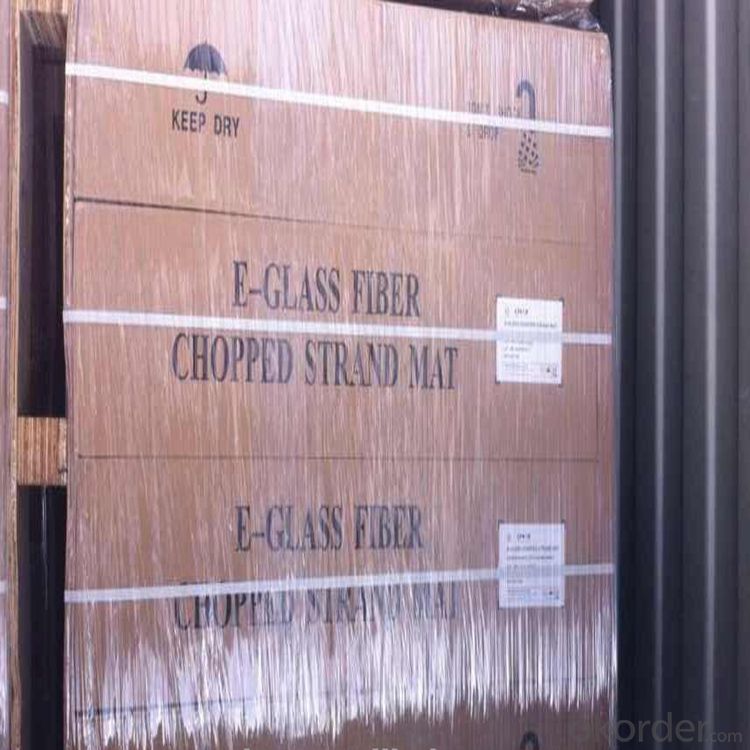
Product Storage:
Unless otherwise specified, Chopped Strand Mat should be stored in a dry, cool and rain-proof area. It is recommended that the room temperature and humidity should be always maintained at 15℃~35℃ and 50%~75% respectively.
Company Information
CNBM (China National Building Material) Group is the largest comprehensive building materials group in China that in integrate scientific research, manufacturing and logistics into one entity. The largest building materials and equipment specialists in China. Upon State Council approval, today CNBM owned more than 300 subordinate manufacturing factories and servicing companies. There are 6 fully owned public listed companies and 11 partially owned with substantial shares public listed companies. In many of these fields, CNBM is playing the leading role in the building industry in the country.

- Q:How is fiberglass chopped strand used in the aerospace industry?
- Fiberglass chopped strand is commonly used in the aerospace industry for various applications. It is primarily employed in the manufacturing of composite materials used in the construction of aircraft components. Chopped strand is mixed with resin to form a composite matrix, which provides strength, stiffness, and lightweight properties to the final product. This material is particularly useful in the production of lightweight aircraft parts such as interior panels, fairings, and non-structural components. Additionally, fiberglass chopped strand can also be used in the repair and maintenance of aerospace equipment, ensuring the longevity and performance of critical aircraft components.
- Q:How to produce automotive front and rear fender-guard.
- 3) hand paste resin with low molecular weight; 2) glass fiber content can not be too high, carbon fiber, woven roving (cloth) etc.. Although the thick aramid fabric is difficult to be soaked with resin manually. (2) The raw material is unsaturated polyester resin; 2) It can be formed at room temperature. Operate the layer repeatly for several times. (3) the advantage 1) It is suitable for the production of a small amount of solvent. The mechanics and thermal properties are limited because of the high techinicals.
- Q:How is the creep resistance of fiberglass chopped strand composites tested?
- Fiberglass chopped strand composites are commonly tested for their creep resistance using a range of methods. One approach involves subjecting the composite material to a constant load or stress for an extended duration, typically at higher temperatures. This method, known as the creep test, allows for the evaluation of the composite's ability to resist deformation and maintain its structural integrity under prolonged load conditions. Throughout the creep test, the composite specimen is placed under constant stress, and its deformation is continuously measured over time. Specialized equipment, such as a creep testing machine, applies the desired load and monitors the deformation. Elevated temperatures are utilized during the test as creep is more apparent under such conditions. The outcomes of the creep test are typically represented as creep curves, which illustrate the relationship between deformation and time under the applied stress. These curves offer valuable insights into the creep behavior of the fiberglass chopped strand composite, including the rate of deformation, the time-dependent nature of creep, and the potential for failure. By assessing the creep resistance of fiberglass chopped strand composites, manufacturers and researchers can determine their suitability for various applications, such as structural components in construction, automotive parts, and aerospace components. This testing ensures that the composite material can endure long-term loading without excessive deformation or failure, instilling confidence in its performance and durability.
- Q:Is fiberglass chopped strand resistant to UV degradation?
- In general, fiberglass chopped strand exhibits resistance to UV degradation. Fiberglass is renowned for its exceptional durability and strong resistance to various environmental elements, including UV radiation. Typically, the glass fibers utilized in fiberglass chopped strand are coated with a protective finish or sizing that imparts an extra layer of UV resistance. This specialized coating serves to safeguard the fibers from the harmful effects of UV rays, thus extending the lifespan of the fiberglass material. Nevertheless, it is crucial to acknowledge that prolonged exposure to intense UV radiation may still result in some level of degradation over time. Therefore, it is advisable to employ additional protective measures, such as applying UV-resistant coatings or utilizing fiberglass materials in shaded areas, to further enhance their UV resistance.
- Q:Can fiberglass chopped strand be used in the production of sporting equipment?
- Certainly, the utilization of fiberglass chopped strand is applicable in the manufacturing of sporting equipment. This versatile material possesses outstanding attributes of strength, endurance, and lightness, rendering it appropriate for diverse applications within the sports industry. It can effectively reinforce and fortify various elements of sporting equipment, including but not limited to tennis rackets, hockey sticks, golf clubs, fishing rods, as well as protective gear like helmets and padding. The incorporation of fiberglass chopped strand can significantly augment the overall performance and longevity of such equipment, enabling improved control, power, and flexibility. Furthermore, fiberglass exhibits resistance towards corrosion, moisture, and various weather conditions, thereby making it an ideal choice for outdoor sporting equipment. All in all, fiberglass chopped strand remains a highly favored option in the production of sporting equipment due to its exceptional mechanical properties and its capacity to enhance performance and durability.
- Q:Can fiberglass chopped strand be used in the production of architectural panels?
- Yes, fiberglass chopped strand can be used in the production of architectural panels. Fiberglass chopped strand is a versatile material that offers high strength and durability, making it suitable for various applications, including architectural panels. The chopped strands are typically mixed with a resin and then molded or formed into the desired panel shape. The resulting panel offers excellent mechanical properties, such as high tensile strength, impact resistance, and dimensional stability. Additionally, fiberglass panels can be easily customized to meet specific design requirements, allowing architects and designers to create unique and aesthetically pleasing structures. Overall, the use of fiberglass chopped strand in the production of architectural panels provides a cost-effective and efficient solution for constructing durable and visually appealing building components.
- Q:Can fiberglass chopped strand be used to reinforce concrete?
- Fiberglass chopped strand is capable of reinforcing concrete. By incorporating the chopped strands into concrete mixtures, the concrete gains supplementary tensile strength, impact resistance, and durability. The fiberglass strands function as a reinforcement material, effectively managing cracking and enhancing the overall structural integrity. This proves particularly advantageous in scenarios where concrete may encounter substantial loads or harsh environmental circumstances. Moreover, fiberglass chopped strand is not only lightweight but also resistant to corrosion, rendering it an optimal selection for concrete reinforcement.
- Q:Is fiberglass chopped strand compatible with different curing methods?
- Yes, fiberglass chopped strand is compatible with different curing methods. Fiberglass chopped strand is commonly used as a reinforcement material in various industries such as automotive, construction, and aerospace. It can be used in conjunction with different curing methods, including thermosetting and thermoplastic processes. In thermosetting processes, such as resin transfer molding (RTM) or vacuum infusion, the fiberglass chopped strand is typically impregnated with a thermosetting resin, which is then cured at elevated temperatures. The resin undergoes a chemical reaction, resulting in a hardened and durable composite material. Fiberglass chopped strand is compatible with these processes as it provides strength and reinforcement to the cured composite. In thermoplastic processes, such as injection molding or compression molding, the fiberglass chopped strand is mixed with a molten thermoplastic resin, which solidifies upon cooling. The chopped strand reinforcement enhances the mechanical properties of the thermoplastic material, making it stronger and more resistant to deformation. Fiberglass chopped strand is compatible with these processes as it can be easily incorporated into the molten resin and distributed evenly throughout the molded part. Overall, fiberglass chopped strand is a versatile material that can be used with different curing methods, providing enhanced strength and durability to the final product. Its compatibility with various processes makes it a preferred choice in industries where high-performance composites are required.
- Q:What material is made of glass fiber pipe?
- Glass fiber reinforced pipe
- Q:How does the electrical conductivity of the chopped strand affect its performance?
- The performance of chopped strand in different applications can be greatly influenced by its electrical conductivity. Generally, electrical conductivity refers to a material's ability to conduct electric current. In the case of chopped strand, which is typically made of glass fibers, the electrical conductivity can vary depending on factors such as the glass composition and the presence of coatings or treatments on the strands. One particular application where electrical conductivity plays a significant role is in composite materials. Chopped strand is commonly used as a reinforcement in composites to enhance their mechanical properties. However, if the chopped strand possesses high electrical conductivity, it can lead to problems associated with electrical grounding or interference. This can be particularly troublesome in applications that require electrical insulation, like electronic enclosures or aerospace components. Conversely, there are certain applications that can actually benefit from a higher electrical conductivity of the chopped strand. For example, in electromagnetic shielding applications, which aim to block or redirect electromagnetic radiation, a conductive chopped strand can improve the shielding's effectiveness. The conductive properties of the chopped strand can aid in dissipating or redirecting the electrical energy, thereby reducing its impact on the surrounding environment. Furthermore, the electrical conductivity of the chopped strand can also affect its resistance to electrical arcing or sparking. In high-voltage applications where the risk of electrical discharge is a concern, using chopped strand with lower electrical conductivity can help minimize the occurrence of arcing and potential damage to the material or surrounding components. To sum up, the electrical conductivity of chopped strand can significantly impact its performance in diverse applications. It is crucial to carefully evaluate the specific requirements of the application and select a chopped strand with the appropriate electrical conductivity to ensure optimal performance and avoid any potential issues related to electrical grounding, interference, or electrical discharge.
1. Manufacturer Overview |
|
|---|---|
| Location | |
| Year Established | |
| Annual Output Value | |
| Main Markets | |
| Company Certifications | |
2. Manufacturer Certificates |
|
|---|---|
| a) Certification Name | |
| Range | |
| Reference | |
| Validity Period | |
3. Manufacturer Capability |
|
|---|---|
| a)Trade Capacity | |
| Nearest Port | |
| Export Percentage | |
| No.of Employees in Trade Department | |
| Language Spoken: | |
| b)Factory Information | |
| Factory Size: | |
| No. of Production Lines | |
| Contract Manufacturing | |
| Product Price Range | |
Send your message to us
100g/m2 Fiberglass Chopped Strand Mat
- Loading Port:
- China main port
- Payment Terms:
- TT OR LC
- Min Order Qty:
- 1 kg
- Supply Capability:
- 5000 kg/month
OKorder Service Pledge
OKorder Financial Service
Similar products
New products
Hot products
Related keywords
